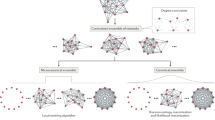Abstract
Networks are being increasingly used to represent relational data. As the patterns of relations tends to be complex, many probabilistic models have been proposed to capture the structural properties of the process that generated the networks. Two features of network phenomena not captured by the simplest models is the variation in the number of relations individual entities have and the clustering of their relations. In this paper we present a statistical model within the curved exponential family class that can represent both arbitrary degree distributions and an average clustering coefficient. We present two tunable parameterizations of the model and give their interpretation. We also present a Markov Chain Monte Carlo (MCMC) algorithm that can be used to generate networks from this model.
Similar content being viewed by others
References
Albert R, Barabási AL (2000) Topology of evolving networks: Local events and universality. Phys Rev Lett 85(24):5234–5237
Barabási AL, Albert R (1999) Emergence of scaling in random networks. Science 286(5439):509–512
Barndorff-Nielsen OE (1978) Information and exponential families in statistical theory. Wiley, New York
Bollobas B (1985) Random graphs. Academic Press, New York
Borgatti SP, Everett MG, Freeman LC (1999) Ucinet 6.0 for Windows. Analytic Technologies, Natick
Dezső Z, Barabási AL (2002) Halting viruses in scale-free networks. Phys Rev E 65:055103
Frank O, Strauss D (1986) Markov graphs. J Am Stat Assoc 81(395):832–842
Geyer CJ, Thompson EA (1992) Constrained Monte Carlo maximum likelihood calculations (with discussion). J R Stat Soc Ser B 54:657–699
Handcock MS (2000) Progress in statistical modeling of drug user and sexual networks. Manuscript, Center for Statistics and the Social Sciences, University of Washington
Handcock MS (2002) Degeneracy and inference for social network models. Paper presented at the Sunbelt XXII international social network conference, New Orleans, LA
Handcock MS (2003a) Assessing degeneracy in statistical models of social networks. Working paper #39, Center for Statistics and the Social Sciences, University of Washington
Handcock MS (2003b) Statistical models for social networks: Inference and degeneracy. In: Breiger R, Carley K, Pattison P (eds) Dynamic social network modeling and analysis. Committee on human factors, board on behavioral, cognitive, and sensory sciences. National Academy Press, Washington, pp 229–240
Handcock MS, Hunter DR, Butts CT, Goodreau SM, Morris M (2003) statnet: Software tools for the statistical modeling of network data. Statnet Project, Seattle, WA. Version 2.0. Project home page at http://statnet.org, http://CRAN.R-project.org/package=statnet
Hunter DR, Handcock MS (2006) Inference in curved exponential family models for networks. J Comput Graph Stat 15:565–583
Irwin J (1963) The place of mathematics in medical and biological statistics. J R Stat Soc Ser A (General) 126(1):1–45
Johnson N, Kotz S, Kemp A (1992) Univariate discrete distributions. Wiley series in probability and mathematical statistics, 2nd edn. Wiley, New York
Jones J, Handcock MS (2003) An assessment of preferential attachment as a mechanism for human sexual network formation. Proc R Soc Lond B 270:1123–1128
Kendall M (1961) Natural law in the social sciences: Presidential address. J R Stat Soc Ser A—Stat Soc 124(1):1–16
Liljeros F, Edling CR, Amaral LAN, Stanley HE, Åberg Y (2001) The web of human sexual contacts. Nature 411(6840):907–908
Morris M (2003) Local rules and global properties: Modeling the emergence of network structure. In: Breiger R, Carley K, Pattison P (eds) Dynamic social network modeling and analysis. Committee on human factors, board on behavioral, cognitive, and sensory sciences. National Academy Press, Washington, pp 174–186
Newman MEJ (2002) Spread of epidemic disease on networks. Phys Rev E 66(1):016128
Newman MEJ (2003) The structure and function of complex networks. SIAM Rev 45(2):167–256
Newman MEJ, Strogatz SH, Watts DJ (2001) Random graphs with arbitrary degree distributions and their applications. Phys Rev E 64:026118
Pastor-Satorras R, Vespignani A (2001) Epidemic dynamics and endemic states in complex networks. Phys Rev E 63(6):066117
R Development Core Team R: (2008) A language and environment for statistical computing. R Foundation for Statistical Computing, Vienna, Austria. Version 2.8.0. ISBN 3-900051-07-0. http://www.R-project.org
Simon H (1955) On a class of skew distribution functions. Biometrika 42(3/4):435–440
Snijders TAB (2002) Markov chain Monte Carlo estimation of exponential random graph models. J Soc Struct 3(2)
Snijders TAB, Pattison P, Robins GL, Handcock MS (2006) New specifications for exponential random graph models. Sociol Methodol 36:99–153
Strauss D, Ikeda M (1990) Pseudolikelihood estimation for social networks. J Am Stat Assoc 85:204–212
Wasserman SS, Faust K (1994) Social network analysis: Methods and applications. Cambridge University Press, Cambridge
Author information
Authors and Affiliations
Corresponding author
Rights and permissions
About this article
Cite this article
Handcock, M.S., Morris, M. A curved exponential family model for complex networks. Comput Math Organ Theory 15, 294–302 (2009). https://doi.org/10.1007/s10588-008-9055-x
Published:
Issue Date:
DOI: https://doi.org/10.1007/s10588-008-9055-x




